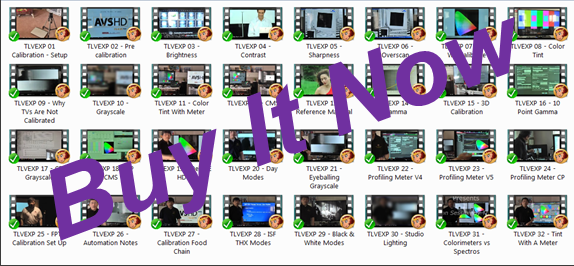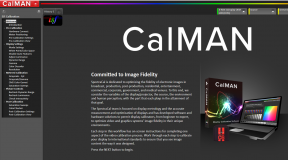Kudos to Pioneer for including only a two watt audio system for the set. No one in their right mind would only use the built in sonics. Too early to tell if this set also produces the brightness pulse that the RCA sets all have (It doesn’t, but there is something much worse.). For color calibration on the Pioneer set, set red and blue bias controls to minimum position and turn all drivers to minimum. Bring up green to desired level, then bring up both blue and red to same level and back off just a bit so that picture is too green. Adjust the two bias controls (mistakenly identified as drivers) to fine tune the colours. Watching the image produced by the Pioneer, it became apparent that the image was being altered a bit from the source. The colour saturation for the satellite reception is not as vivid as it should be and the reason is not related to the larger picture size. In order to achieve the wider aspect ratio, the set appears to be digitally processing the signal (the dreaded DSP) hence causing the drop in color saturation and creating a slight digitized (digital artifacts) look on all materials. To my horror and disappointment, the sharpness of the 46″ image has been significantly dulled on this 51″ image. The vertical size cannot be adjusted any further without severely distorting the picture. As with the Seed direct view set, reducing the top and bottom overscan compresses the top and bottom 20% or so much more than the rest of the picture. The result is that Commander Riker gets a very small head compared to the rest of his body. The convergence also goes off as the image is compressed particularly in the top left corner. The image has been restored to factory specifications in this area. Horizontal sizing permitted further reduction of the left and right overscan with a barely noticeable, if any, convergence penalty. (Need to put Alien3 in to check the graphics.) Am I happy with the set? … I doubt that I would be perfectly happy with any set, but weighing the pluses and minuses of this unit with the RCA is likely close to a draw. The Pioneer set will need a further burn in period of a few more months before the jury can finally be in. (As an aside, Wai’s Mitsubishi projection television turns out to use the same concepts in terms of colour adjustments as the Pioneer. This is a significant departure from their old sets which still used bias controls. However, he can only make the micro adjustments from an on screen menu display so he needed the $65 manual … ouch. There are some elements of his set that remind me to go back into the Mitsubishi in order to turn down the overall contrast level.) Major tweak is in the works for the Pioneer set as I am about to replace the existing lenticular screen with a custom built albeit low technology glass screen which, in theory, should improve the projected image. The screen will be a three millimeter thick glass plate with a white frost sand blasted on one side. This will give the projected image a more movie screen like surface to be projected upon hence significantly increasing the brightness of the image. The existing screen has a gray finish while the new screen will be closer to white. The clear glass surface will face the viewer creating a tubelike appearance for the image. The lenticular surface of the existing screen serves to diffuse any direct room light, but it also ends up decreasing the brightness of the television since it diffuses the light from the image as well. This will probably force the image to be projected in more controlled lighting. More later as the screen actually arrives and gets installed. The cost for this screen is less than $60 versus the OEM screen which can sell for $800. I just won’t be sending anyone’s head through the screen on purpose. The slight green tint inherent in all glass products may have an impact on the colour and may ultimately mean further colour adjustments, but I will tackle that when the time comes. A controlled test of what the image may end up looking like was conducted on the RCA set with unsettling results. Using white sheets of paper in lieu of the screen, the daylight in the room was too great for the image to even be visible at current settings. It was only after turning the contrast up that the image started to appear. I understand more about what I will likely end up with. The new screen will give the projection set the qualities of a front projection set as well as their inherent weaknesses such and the need for total ambient light control. The image will become almost unwatchable in the day time, but the night images should be cleaner and brighter. It was an experiment and the result was a failure although a significant learning experience. There were two distinctly different images from the same piece of glass. With the frosted side facing outward, the image had stable colours, but had an unacceptable hot spot which would wash out the rest of the image. The hot spot would follow the viewer no matter where they sat or stood to watch the image. With the frost turned inward, the image still had a hot spot, but the three guns could no longer form a coherent single coloured image. All images clearly had red, green and blue components from left to right which made for a worse viewing experience than I had thought possible. As a contrast screen, the glass still has potential. For all the years of questions regarding this screen dilemma, it has been settled in one fowl swoop. If I want a replacement screen, I will be forced to contact Da Lite Screens in the states. Starting at $50 a square foot too, ouch. I’ve just about had it with this Pioneer TV as I have disconnected it and pushed it behind the sofa. Back to the “beautiful” RCA set where flaws are far more bearable. There is an inherent problem with a set that handles every movie differently displaying disastrous results on an increasing basis. The Pioneer people are now in internal discussions with regard to the next logical step. Make room for another entry. I’m not quite sure what it will be, but the candidates are Toshiba 48″, Hitachi 50″, Sony 41″, JVC 55″, or even a Panasonic 51.” Forget all of those and add the Proscan PS34190 to the list. In the middle of August 1998, I got my first opportunity to see a HDTV image from a demonstration being sponsored by Panasonic at two local stores in the Minneapolis area. The set in question was a 56 inch 16:9 set priced at $5500, but lacking a HDTV tuner which would need to be added at additional cost further down the road. (Another $1500 at least.) The demonstration was being conducted with a 50 inch 4:3 set by its side for comparison purposes. A down conversion device was present to convert the original DTV signal to analog. The resulting image on the 4:3 set was matted at 1.66:1. The HDTV image was actually cropping the image a bit on the top and bottom. This would indicate that the source material was not formatted for just the HDTV format or that the set itself was overscanning the image badly. I suspect that the playback device was a high definition Laserdisc system. (It was actually a WVHS VCR) From 20 feet back, the HD image brought tears to the eyes. It was so clear, sharp and solid that it looked like film. A very good version of what the Proscan can show when the proper material is fed into the system. I swear the image was a progressive scan image. The down converted image on the 4:3 set was also comparatively excellent to the other sets that were just showing broadcast materials. While we talk about televisions, an opportunity to get a Colour Analyzer has appeared and I am thinking most seriously about it. It could be a chance to grow a hobby job into something bigger and better. I went ahead and bought the device from Ambrosia A/V in Los Angeles. The unit was essentially brand new and sold for $2,900 U.S. It was then shipped via UPS to me in Calgary. I have only seen this unit once before in Minneapolis, but this time, it would be mine to use. Here is a preliminary comparison of how the two (three) sets stack up against each other:
Blast From The Past … Genesis of a Calibrator … Part 2
Michael Chen
May 20, 2013
Michael Chen
Michael Chen is the only THX Video Systems Instructor in Canada, and beyond these borders, is one of just two THX Video Instructors in the entire world. He has actively consulted with Spectracal and ChromaPure and has created numerous education videos on the calibration process with still more to come. His Video Calibration Training Series has quickly become the most comprehensive and simple to understand learning tool on the market today. He has also taught classes for both the ISF and Spectracal as well and is now spearheading his all new TLVEXP calibration training program. Let Michael teach you Video Calibration and add that additional income stream to your installation and integration business





